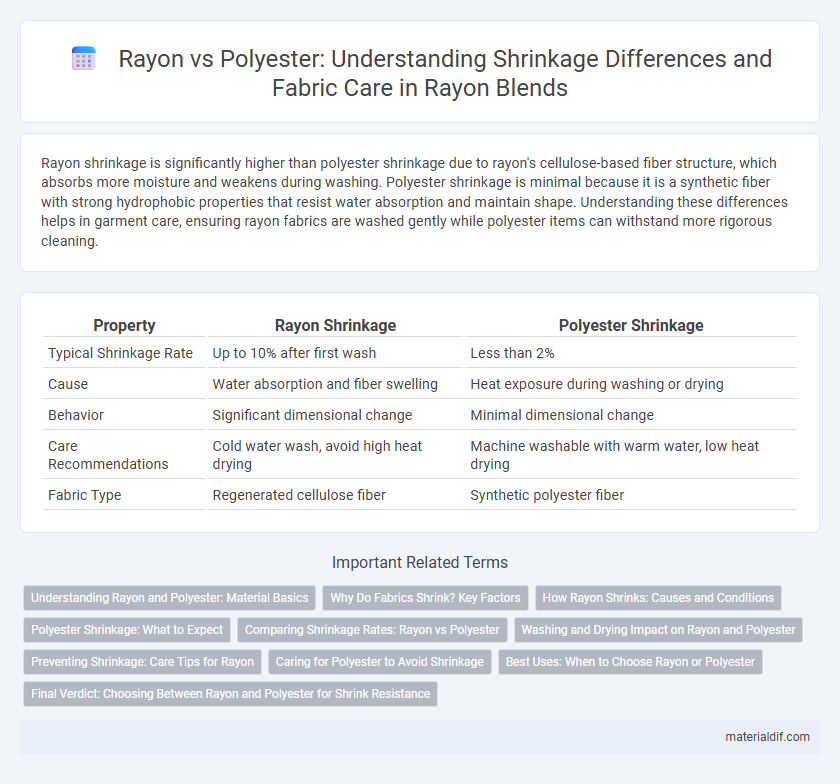Rayon shrinkage is significantly higher than polyester shrinkage due to rayon's cellulose-based fiber structure, which absorbs more moisture and weakens during washing. Polyester shrinkage is minimal because it is a synthetic fiber with strong hydrophobic properties that resist water absorption and maintain shape. Understanding these differences helps in garment care, ensuring rayon fabrics are washed gently while polyester items can withstand more rigorous cleaning.
Table of Comparison
| Property | Rayon Shrinkage | Polyester Shrinkage |
|---|---|---|
| Typical Shrinkage Rate | Up to 10% after first wash | Less than 2% |
| Cause | Water absorption and fiber swelling | Heat exposure during washing or drying |
| Behavior | Significant dimensional change | Minimal dimensional change |
| Care Recommendations | Cold water wash, avoid high heat drying | Machine washable with warm water, low heat drying |
| Fabric Type | Regenerated cellulose fiber | Synthetic polyester fiber |
Understanding Rayon and Polyester: Material Basics
Rayon exhibits higher shrinkage rates compared to polyester due to its semi-synthetic cellulose-based fibers that absorb moisture and swell during washing. Polyester, a fully synthetic polymer, remains dimensionally stable with minimal shrinkage because of its hydrophobic molecular structure. Understanding these material properties helps in selecting fibers based on durability and care requirements for textiles.
Why Do Fabrics Shrink? Key Factors
Fabrics shrink due to a combination of fiber properties, manufacturing processes, and environmental conditions such as heat, moisture, and mechanical agitation. Rayon, a semi-synthetic fiber made from regenerated cellulose, tends to shrink more than polyester because its cellulose structure absorbs water and weakens under heat, causing fibers to contract. Polyester, a synthetic polymer, exhibits higher dimensional stability and resistance to shrinkage due to its hydrophobic nature and strong molecular bonds.
How Rayon Shrinks: Causes and Conditions
Rayon experiences significant shrinkage primarily due to its cellulose-based fibers absorbing water, which causes the fibers to swell and contract during washing or exposure to moisture. Heat and agitation during laundering exacerbate the fiber tension release, leading to dimensional changes and reduction in fabric size. Unlike polyester, which is synthetic and heat-set to minimize shrinkage, rayon's natural fiber structure makes it highly susceptible to moisture-induced shrinkage under improper care conditions.
Polyester Shrinkage: What to Expect
Polyester shrinkage typically ranges from 1% to 3%, making it highly stable compared to rayon, which can shrink up to 10% or more when exposed to heat and moisture. Polyester fibers resist water absorption, thereby maintaining their shape and size after washing, unlike rayon which is prone to significant dimensional changes. Understanding polyester shrinkage is crucial for garment care, ensuring durability and a consistent fit over time.
Comparing Shrinkage Rates: Rayon vs Polyester
Rayon exhibits a higher shrinkage rate compared to polyester, typically shrinking between 10-15% when exposed to water and heat, whereas polyester shrinkage remains minimal, usually under 3%. This significant difference is due to rayon's cellulose-based fibers, which absorb moisture readily causing fiber relaxation and contraction, while polyester's synthetic fibers are hydrophobic and retain their shape better under laundering. Understanding these shrinkage rates is crucial for garment manufacturing and care, as rayon requires more careful handling to maintain size and fit.
Washing and Drying Impact on Rayon and Polyester
Rayon experiences higher shrinkage than polyester due to its natural cellulose fibers, which absorb more water and swell during washing. Polyester, a synthetic fiber, maintains dimensional stability with minimal shrinkage when exposed to heat and moisture in washing and drying. Proper care, including washing rayon in cold water and air drying, reduces shrinkage, while polyester can withstand higher temperatures without significant loss of size or shape.
Preventing Shrinkage: Care Tips for Rayon
Rayon typically experiences higher shrinkage than polyester due to its natural cellulose fibers, which absorb more moisture and swell during washing. To prevent shrinkage in rayon, use cold water washes, avoid high heat in dryers, and opt for air drying or low-heat tumble drying. Polyester's synthetic fibers provide greater dimensional stability, making it less prone to shrinkage under similar care conditions.
Caring for Polyester to Avoid Shrinkage
Polyester exhibits significantly lower shrinkage compared to rayon, making it more durable and easier to care for in daily use. To prevent polyester shrinkage, wash garments in cold water and avoid high heat drying by opting for air drying or low-temperature tumble drying. Proper care preserves polyester's dimensional stability and extends the lifespan of synthetic fibers in clothing.
Best Uses: When to Choose Rayon or Polyester
Rayon exhibits higher shrinkage rates compared to polyester, making it ideal for applications where softness and breathability are prioritized over durability. Polyester's low shrinkage and high wrinkle resistance suit it best for activewear, outdoor gear, and items requiring frequent washing. Choosing between rayon and polyester depends on whether the fabric's comfort or dimensional stability is more critical for the intended use.
Final Verdict: Choosing Between Rayon and Polyester for Shrink Resistance
Rayon typically experiences greater shrinkage compared to polyester due to its natural fiber origin and higher moisture absorption rate. Polyester's synthetic composition offers superior dimensional stability and minimal shrinkage when exposed to water or heat, making it ideal for garments requiring long-term shape retention. Choosing polyester over rayon ensures enhanced shrink resistance, especially in applications demanding frequent washing or exposure to varying environmental conditions.
Rayon Shrinkage vs Polyester Shrinkage Infographic

 materialdif.com
materialdif.com